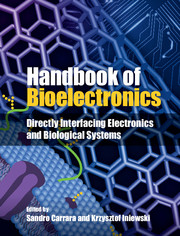Book contents
- Frontmatter
- Contents
- List of Contributors
- 1 What is bioelectronics?
- Part I Electronic components
- Part II Biosensors
- Part III Fuel cells
- Part IV Biomimetic systems
- Part V Bionics
- Part VI Brain interfaces
- Part VII Lab-on-a-chip
- 35 Lab-on-a-chip
- 36 CMOS spectrally multiplexed FRET contact imaging microsystem for DNA analysis
- 37 CMOS electrochemical biosensors: instrumentation and integration
- 38 Adaptive and reconfiguration-based error recovery in cyberphysical biochips
- 39 CMOS-based biomolecular sensor system-on-chip
- Part VIII Future perspectives
- Index
- References
37 - CMOS electrochemical biosensors: instrumentation and integration
from Part VII - Lab-on-a-chip
Published online by Cambridge University Press: 05 September 2015
- Frontmatter
- Contents
- List of Contributors
- 1 What is bioelectronics?
- Part I Electronic components
- Part II Biosensors
- Part III Fuel cells
- Part IV Biomimetic systems
- Part V Bionics
- Part VI Brain interfaces
- Part VII Lab-on-a-chip
- 35 Lab-on-a-chip
- 36 CMOS spectrally multiplexed FRET contact imaging microsystem for DNA analysis
- 37 CMOS electrochemical biosensors: instrumentation and integration
- 38 Adaptive and reconfiguration-based error recovery in cyberphysical biochips
- 39 CMOS-based biomolecular sensor system-on-chip
- Part VIII Future perspectives
- Index
- References
Summary
Introduction
There is an opportunity for greatly increased synergy between electronics and biology, fostered by the march of electronics technologies to the atomic scale, and by rapid advances in system, cell, and molecular biology. The convergence of biology and electronics has the potential for significant impacts on many areas important to national economies and well-being, including healthcare and medicine, homeland security, forensics, and protecting the environment and the food supply. Electrochemical biosensors are label-free detection, which eliminates the external labels or indicators and greatly shortens the assay time. They are widely used for the detection of protein binding events, hybridized DNA, neuron tissue, bacteria, and enzyme reactions.
Miniaturized sensor arrays are capable of parallel analysis of multiple parameters. Because of the distinct advantages of microsystem platforms, there has been a trend to integrate sensor arrays onto the surface of silicon chips and perform measurement using on-chip CMOS electronics [1–3]. At the same time, there is a great opportunity to expand lab-on-a-chip solutions that replace bulky benchtop sample analysis tools with simple, low-power, portable systems. The fabrication compatibility between many bio/chemical sensor interfaces and CMOS technology makes a CMOS circuit an outstanding candidate for a silicon-based lab-on-chip solution [4].
- Type
- Chapter
- Information
- Handbook of BioelectronicsDirectly Interfacing Electronics and Biological Systems, pp. 448 - 468Publisher: Cambridge University PressPrint publication year: 2015

